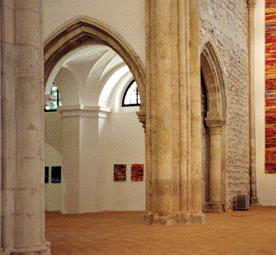
Temporary Exhibitions
Former Monastery Church

exhibitions
2023
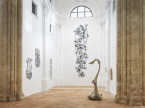
Damijan Kracina: Wrong Ship
Former monastery church, 29 September 2023 - 25 February 2024
The exhibition entitled Wrong Ship installation by the artist Damijan Kracina presents an integral spatial installation, composed of a combination of new and older materials that introduce multifaceted meanings through their narratives and visual designs. In these works, the artist consistently introduces fictional, fantastical, dystopian, and perhaps fairly plausible scenarios of potential futures of various living beings that inhabit the planet Earth.
With this exhibition, Kracina continues his characteristic artistic practice in which he often presents satirical interpretations of coexistence between different kinds of living beings and technological devices that are commonly conveyed through visual means into humorous objects and spatial installations. Over the past two decades, he has frequently created forms and images of imaginary living beings that could have existed in the geological history but became victims of one of the major extinctions in the planet’s long history. With his more recent works, he still ironically responds to interpretations of evolutionary theories and other hypotheses about the origin of the world, which continue to be controversial even in the age of empirical science. At the same time, he alludes to current environmental imbalances of the modern world, where a large multitude of wild living beings are condemned to extinction due to the unchecked expansion of humans as the ultimate invasive species. The Wrong Ship exhibition thus introduces the idea of an attempt by the human species to escape from an overpopulated planet with a space vessel that ostensibly provides passengers with almost all the comforts associated with modern lifestyles. The escape to the depths beyond the limits of human perception, where travellers or escapees might find a more favourable environment that can be utilized and exploited for longer and more extensively, is marked by eternal desire of human kind for complete primacy and eternal exploration of new worlds and organisms.

Revolt 1573-2023
Grand Gallery of GBJ, 19 July - 1 October 2023
The exhibition ‘Revolt 1573-2023. Exhibition of Iconic Artworks about the Great Peasant Revolt 1573’ commemorates the 450th anniversary of Great Peasant Revolt of 1573 by exploring the widespread presence of peasant revolt as a theme the arts in the past 150 years. The exhibition showcases works of selected artists, mostly from Slovenia and Croatia, who reflected on this historical event in different periods of time and socio-political circumstances.
In the area of present-day Slovenia and Croatia, the historic event known as the 1573 Great Peasant Revolt came into the collective memory during the second half of the 19th century. By that time this almost forgotten event gained a constitutive and emancipatory status in Croatian and Slovenian national mythologies due to the links that were created with the struggle of the Slav ethnic groups in the Habsburg and Hungarian empires while Matija Gubec, leader of peasants, became a folk hero, who revolted against foreign rule. It was art that placed the striking political potential of the peasant revolt, that became symbol of ongoing historical struggle for social and political rights of deprivileged, into the public discourse.
A rise in the depictions of the peasant revolt and their protagonists emerged with the establishment of the Kingdom of Yugoslavia. At the time the rebellious peasants were perceived as the first fighters for the freedom of Slavs from under foreign rule. During World War II (1941-1945) Matija Gubec and the spirit of the peasant revolt were linked to the uprise against the fascist and Nazi occupiers while Matija Gubec was also promoted as a Croatian national hero in the NDH (Independent State of Croatia) propaganda. The greatest bloom in reviving the peasant revolt occurred in the period of the Socialist Federal Republic of Yugoslavia, when parallels were drawn between this historical episode and the proletarian and socialist revolution of the masses against the capitalist (feudal) elites. Most artworks depicting the peasant revolt were created around 1973, on the 400th anniversary of the Great Peasant Revolt. Following the decline of the socialist order and the disintegration of Yugoslavia in 1991, the peasant revolt almost disappeared from the public discourse and thus also from art.
The exhibition showcases works of following artists:
Antun Augustinčić, Alenka Bartl, Janez Bernik, Vera Dajht Kralj, Riko Debenjak, Marijan Detoni, Lojze Dolinar, Zorislav Drempetić Hrčić, Robert Frangeš Mihanović, Vito Globočnik, Željko Hegedušić, Oton Iveković, Vasilije Jordan, Jakob Klemenčič, Ferdo Kulmer, Peter Kuntarič, Ivan Lovrenčić, Boštjan Kavčič, Gojmir Anton Kos, Ivan Kožarić, Tone Kralj, Miha Maleš, Erik Mavrič, France Mihelič, Franc Peršin, Darije Petković, Ferdinand Quiquerez, Branko Ružić, Ivan Seljak Čopič, Albert Sirk, Zlatko Sirotić, Matija Skurjeni, Miljenko Stančić, Marin Studin, Gabrijel Stupica, Kamilo Tompa, Sandra Vitaljić, Jože Volarič, Dušan Vukotić, Šime Vulas in drugi.
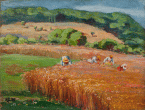
Nadežda Petrović. The Modern, the National and Her Slovenian Colleagues
Grand Gallery of GBJ, 12 May - 9 July 2023
The exhibition of Nadežda Petrović and her Slovenian colleagues focuses on the early developments of modern art in Central and Southeast Europe. Nadežda Petrović was a versatile artist and personality who was active in the fields of painting, art criticism, photography, education, women’s emancipation, and with topical political as well as national issues; she was therefore actively involved in the social and artistic processes at the beginning of the 20th century, while she aimed to directly influence them with constant struggle for the progress of society and humanity. Furthermore, she was one of the few European female artists who active and successful in the period 1900-1915. The exhibition in Galerija Božidar Jakac – Museum of Modern and Contemporary Art showcases her extensive body of work in dialogue with her Slovenian colleagues, companions and contemporaries, who are nowadays known as the central figures of Slovenian Impressionism.
Nadežda Petrović was one of the key figures of early modernism, both in Serbia as well as in the wider area of Southeast Europe. In the period leading up to the World War One, she was a vocal supporter of the idea of unification the South Slavic ethnic groups in one state (Yugoslavia). In doing so, she also had counterparts in the generation of artists that we know nowadays as Slovenian Impressionists. In her creative practice, she followed various styles and movements of the time; first she worked under influence of academic realism, then Impressionism, and later on she adopted the impulses of Fauvism and German Expressionism. In her work, one can to follow a development from the Munich period, when she depicted local landscapes and peoples, impressionist episodes and national narratives, to the works that created in Paris, when she probably reached the peak of her own art practice with the predominance of visual features over ideological content.
The exhibition showcases 94 paintings by Nadežda Petrović, which are put in constructive dialogue with 30 paintings by Slovenian artists such as Anton Ažbe, Ivan Grohar, Matija Jama, Matej Sternen, Rihard Jakopič and Ferdo Vesel. The art works are from various museums and collections: National Museum of Serbia, Museum of Contemporary Art (Belgrade), Nadežda Petrović Art Gallery (Čačak), Pavel Beljanski Memorial Collection, Galerija Matice Srpske (Novi Sad), National Gallery of Slovenia, Museum of Modern Art, Museum and galleries of Ljubljana, National Museum (Ljubljana), Krka Art Collection, d.d. (Novo mesto).
The travelling exhibition began at the National Museum of Serbia in Belgrade, the second edition is the exhibition at Galerija Božidar Jakac, and then the tour continues to the Museum of Contemporary Art RS in Banja Luka, Nadežda Petrović Art Gallery in Čačak and Contemporary Art Gallery in Niš (in collaboration with Art Colony Sićevo).
The exhibition Nadežda Petrović: The Modern, the National and Her Slovenian Colleagues is a result of collaboration with National Museum of Serbia from Belgrade and National Gallery of Slovenia from Ljubljana.
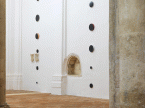
Vadim Fishkin: Dark Times
former monastery church, 5 May - 27 August 2023
The exhibition of the artist Vadim Fiškin entitled Dark Times showcases the work, in which he continues and deepens his artistic explorations of the phenomenon of time, light and consequently space. In the interior of the former monastery church, the artist establishes with minimal visual and sonic means an integrated spatial intervention, in which the central elements consist of multitude of wall clocks painted black and their endlessly repetitive sounds.
With this ambiguous work the artist relates to the exhibition space itself, since he, in visual sense, aims to establish optical interaction between modern elements and historic architecture, while the component of sound is based on the ticking of clocks that creates an almost controlled sonic cacophony in the acoustic space of the gallery. The exhibition thus merges the seemingly contradictory notions of the undetermined and the mundane because time and measuring time belong to both aforementioned poles simultaneously. In his creative practice, Fishkin has been devoting himself to reflection of human and societal relationship with time on various levels for at least two decades; in the work A Speedy Day (2003) he shortened period of whole day to only few minutes as a result of high speed travelling in space, in the work Choose Your Day (2005) he simulated an imaginary journey through different times and places in an autonomous space, while he turned the clock mechanism, caught in quiescence, into a metaphorical play of meanings in the work Stretched Time (2016 ). The work Dark Times on the other hand persistently reminds the audience with its visual and sonic appearance that every part of life is just one of the sounds in relentless countdown of intervals to the final end, be it the end of life or the end of the world. Time is thus never completely neutral, as society attributes many characteristics to it depending on current general circumstances. Figuratively speaking the times can be favourable or difficult, happy or gloomy, golden or dark, but this does not change the fact that according to human perception, time always flows in the same sequence, while in science always questions that very notion. Despite its non-mimetic nature and semantic ambivalence, Fiškin’s sonic and visual intervention addresses some fundamental questions of the modern world – the measuring time and (an attempt to) understand its passing.
2022

Maša Jazbec: Synthetic Organisms
Former monastery church, 9 September 2022 - 26 March 2023
With the exhibition Synthetic Organisms, the artist and researcher Maša Jazbec focuses on the ideas about the coexistence of humans and robots which is the synthesis of the years of research in humanoid robots. A spatial installation in the former monastery church addresses number of fundamental, social and ethical questions with visual means about understanding of life and being alive, the relationship between organic and inorganic matter, and possible substitutability of the human kind.
In her work the artist deals with numerous challenges of modern time, related with the perception and use of advanced technologies, through the perspective of social complexity, thus her works surpass the technical aspects of robotics and address above all the related conceptual and existential questions. She does not perceive contemporary technologies as self-evident but she rather analyses them in relation to topical socio-political realities. In her multi-layered practice, Jazbec works as an artist as well as academic researcher in the field of humanoid robotics, and she uses her findings in her artworks, which analyse and predict the possible futures of our civilisation. The exhibition is based on the sculptures of imaginary androids, however, beside the scientific paradigms of robotics it also refers to science fiction literature and film, which represented an important factor in the understanding of our potential futures in the previous century. Jazbec has enriched robotics as a precise interdisciplinary science with sociological and philosophical questioning of what it means to be human today. State of mind of the human kind is also being reflected through our attitude towards robots.
Maša Jazbec is an artist, academic researcher, curator and producer who is active in several fields where science and art intersect and merge. In her interdisciplinary creative practice, she explores influence of robotics and other contemporary and advanced technologies on the lives of people and other living organisms. She graduated from visual arts at the Faculty of Education in Maribor, then finished her MA course on the Interface Culture programme at the University of Linz (Austria), took part in the student exchange at the IAMAS institute (Japan), and she holds PhD in human informatics that was attained at the University of Tsukuba (Japan). Moreover, she was a visiting researcher at the laboratory of professor Hiroshi Ishiguro in Kyoto (Japan). From 2019 she has been the head of the laboratory of Research and Culture Centres at entrepreneur accelerator Katapult, part of Delavski dom Trbovlje, where she works in the interdisciplinary fields such as art, science and new technologies. She was a guest professor at the programme Interface Culture at the University of Arts and Design in Linz, and a member of a jury of the Golden Nica award at the Ars Electronica festival. She lives and works in Trbovlje, Slovenia.
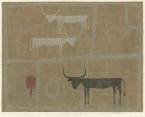
Vladimir Makuc: A Retrospective
Grand Gallery of GBJ, 15 June - 2 October 2022
The major retrospective at Galerija Božidar Jakac showcases a comprehensive overview of the artistic endeavour of Vladimir Makuc who is considered to be one of the most iconic visual artists from Slovenia. Even though he was initially acclaimed as a master of printmaking the exhibition presents different developmental phases of his distinctly interdisciplinary practice which also extends to the fields of drawing, painting, sculpture, ceramics, and various hybrid techniques. Makuc has therefore continuously explored and modified the course of his artistic expression.
The exhibition centres on the extensive donation by Vladimir Makuc to the collection of Galerija Božidar Jakac which includes 53 prints from the period 1957-1999 and demonstrates the evolution of his artistic practice in chronological order. Displayed are some rarely seen early works from the 1950s when the artist was still searching for his formal expression and subject matter, recognisable works from his mature creative period that have been inscribed in the local history of art, and his late works, after 2000, when he largely abandoned printmaking. Because of his diversity and creative curiosity Makuc is perceived as one of the most influential and recognisable modern artists in the Slovenian cultural milieu in the second half of the 20th century.
Makuc’s creative journey spanned seven decades and was constantly developing and altering, in accordance with his personal and artistic visions as well as with the zeitgeist. His iconic position within Slovenian cultural history is conditioned with style and iconography of his works, world view, and reconciliation with his own position of being an interpreter of the Mediterranean cultural landscape. The exhibition portrays Makuc as a human being and as an artist of his time and place who was influenced by contemporary currents in society, culture, and art. Despite the fact that he seemingly resorted to intimate and archaic modes of expression, his artistic practice was always closely intertwined with real events from his life, drawing on both with his personal experience and on collective memory.
The exhibition showcases works from the collection of Galerija Božidar Jakac, Goriški muzej, Galerija Antikvitete Novak as well as from Vladimir Makuc’s archive and private collections.
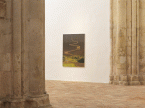
Staš Kleindienst: Antiarcadia
Former monastery church, 6 May - 28 August 2022
Staš Kleindienst’s exhibition entitled Anticardia showcases paintings from his latest creative period, some of which have never been exhibited before. The artist has expanded his body of work for this exhibition with an intervention, a mural that connects his oeuvre and adds another dimension to the exhibition. The exhibition could hardly have come at a better time, for we are (hopefully) coming to the end of the pandemic that has brought the world to a standstill for two years, changed our habits and relations and turned our ideas of ‘normality’ upside down. We can identify with the depictions of urban ruins, time capsules of the unexperienced past and the frozen moments of human confusion, apathy and submissiveness. The dystopian landscapes and events in Kleindienst’s artworks suddenly seem exceptionally close, almost as if they were taken from our everyday lives. The audience is thus confronted by prisms that direct the reading of the exhibition and individual works of art, which are, each in their own way, a universe in themselves.
Staš Kleindienst graduated from the Academy of Fine Arts and Design in Ljubljana in 2007, where he also defended his MA in 2009. His works can be found in a number of private and public collections. In 2014 he received the OHO Group Award and he also, amongst others, curated the student exhibition titled 12 reasons for Painting in the ŠKUC Gallery in 2018. In 2019 The University of Ljubljana awarded him the Recognition of Important Works of Art. He lives and works in Vipava.
Curator: Asta Vrečko.

Postproduction: From the Collection of the Art Stays Festival
Grand gallery of GBJ, 18 March-15 May 2022
The visiting group exhibition Postproduction: From the Art Collection of the Arts Stays Festival will present a selection of works from Ptuj’s international contemporary art festival Art Stays in Galerija Božidar Jakac’s main gallery. In 2022 the festival will celebrate twenty years of uninterrupted operation and the exhibition will also be presented in Ptuj.
The exhibition will present an international selection of works by various contemporary artists that are connected by the strong spatial component, sound-visual associativity and their connections to the meaning of certain fundamental postulates of the human species, here and now. The exhibition will show works by artists who have presented their works at the Art Stays festival in Ptuj over the past two decades as well as works coproduced by or donated to the Art Stays art collection. This exhibition presents the first public presentation of the collection, and is as such viewed by the organisers as a great opportunity as well as a great responsibility to analyse the work carried out so far through an overview and ‘postproduction’ of the twenty years of the festival and outline the new directions of developing the festival in the sense of continuity and greater implementation of the Art Stays festival into the offer/image/life of the region and the local community.
The exhibition Postproduction: From the Art Collection of the Art Stays Festival will take place within the exchange programme of the Slovene Association of Historic Towns and presents a cultural exchange between the towns of Ptuj and Kostanjevica na Krki. The second part of the exchange will bring A Retrospective of Silvan Omerzu, which was on display at the Božidar Jakac Art Museum in 2020-2021, to the Ptuj City Gallery.
Artists at the exhibition:
Felipe Aguila, Lynn Book, Beti Bricelj, BridA, Garry Cass & S. Chandrasekaran, Nemanja Cvijanović, Leo Ferdinad Demetz, Maitha Demithan, Jarmila Džuppová, Dušan Fišer, Pavel Forman, Rok Golob, Interno3 (Manuel Frara), Jaša, Matthias Langer, Raphael Di Luzio, Polona Maher, Zul Mahmod, Robin Meier, Muzikačaka (Sara Korošec), Noriko Obara, Mark Požlep, László László Révész, Tim Roeloffs, Kimitake Sato, Marek Schovanek, Joachim Seinfeld, Tanja Špenko, Transversal Project (Erika Vicari), Verena Fanny Trausch, Elisabeth Wedenig.
Curators of the exhibition: Jernej Forbici & Marika Vicari
2021
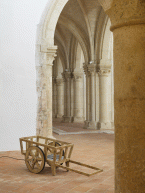
Tomaž Furlan
I Made This
former monastery church, 24 September 2021-27 March 2022
The exhibition I Made This consists of spatial works created by Tomaž Furlan, sculptor and multimedia artist, who often addresses the complex relationships between humans, our environment and the everyday banalities. His latest work consists of a series of objects, with which he directly, materially and self-reflectively addresses the social dynamics between the so-called civilised society and its most common accessories. A series of sculptures, installations and spatial interventions created from robust materials, such as stone, terazzo concrete, marble and wood are on display in the Former Monastery Church.
Tomaž Furlan’s artistic practice is deeply interwoven with a humorous and ironic attitude to situations that an individual might face in his everyday life and that he is, in the spirit of the times, forced to solve in the manner of optimal efficiency. In 2005 he started constructing a series of absurd machines that share the name Wear, in which sculptured objects are used as body extremities and elements of set design in video performances. His sculptures and installations question the society of unavoidable effectiveness, in which there is no space for useless objects that do not have a practical and potentially monetary value. Furlan continues to question this topic in his most recent artworks. Within this exhibition he addresses the omnipresent idea of ‘common sense’, which is supposedly the criterion for rationality and efficiency. As a result, he presents seemingly trivial objects, which (possibly subconsciously) govern human lives. In his recognisable style, interwoven with self-irony and distanced from his own position, he exposes the absurdity of objects he created and the ideas that they represent. Due to their questionable functionality these seemingly common objects can be understood as merely (useless) works of art.
The exhibition will be on display until 27 March 2022.

Ties. Academy of Fine Arts in Zagreb and Slovenian Artists Between the Two Wars
The exhibition Ties. Academy of Fine Arts in Zagreb and Slovenian Artists Between the Two Wars presents artist who studied in Zagreb and their works prior to World War II. The exhibition represents the influences, ties and cooperation between Slovenian and Croatian artists and addresses certain central artistic and social questions that were explored during that period – from national artistic expression to socially engaged art.
In the period between the two wars Zagreb was a bustling metropolis, a cultural and educational centre with the only Academy of Fine Arts in the Kingdom of Yugoslavia. The Academy was established in 1907 and led by Ivan Meštrović between 1923 to 1944. A lot of the students came to study in Zagreb from other parts of the Kingdom, including almost one hundred Slovenian artists (for example Zoran Mušič, Gabrijel Stupica, Zoran Didek, France Mihelič, Miha Maleš, France Gorše, Nikolaj Pirnat, Marij Pregelj, Maksim Sedej, Mira Pregelj, Frančišek Smerdu, Boris and Zdenko Kalin, Bara Remec and many others). Many left a mark on Slovenian art and culture as painters, sculptors, set designers, art educators, cultural workers, theoreticians and, eventually, professors at the Academy of Fine Arts in Ljubljana, which was established in 1945. Long-term friendships were formed between the artists that emerged from the Zagreb Academy, former professors and students became colleagues, former schoolmates became co-workers, artists exhibited and cooperated in associations, they sat on committees together and together they shaped 20th Century art.
The exhibition showcases over 130 paintings, sculptures and graphic prints by the most renown Slovenian artists as well as vast archive material from their time spent at the academy. Some works had already been exhibited together before the war, while others are on display in Slovenia for the very first time. The artworks by Slovenian artists are presented together with the works of their Croatian colleagues Antun Motika, Oton Postružnik, Marijan Detoni, Fran Šimunović, Slavko Kopač and professors Ljubo Babić, Vladimir Becić, Ivan Meštrović, Krsto Hegedušić, Marino Tartaglia and others.
The exhibition that emerged in cooperation between three Slovenian and Croatian institutions (Božidar Jakac Art Museum, Kostanjevica na Krki, National Museum of Modern Art, Zagreb and Academy of Fine Arts, Zagreb) was conceived and created by dr. Asta Vrečko and Dajana Vlaisavljević.
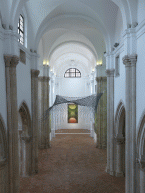
Aleksij Kobal & Manca Ahlin
Dilemmas Crisscrossed
Former Monastery Church, 21. 5. - 5. 9. 2021
The exhibition Dilemmas Crisscrossed by the painter Aleksij Kobal and designer Manca Ahlin that focuses on the universal issues of infinity and cyclicity will establish a unified ambience within the former monastery church. The jointly created work merges what seem to be two different practices into a coherent artistic whole that addresses the public on the visual as well as metaphysical level.
In the creation of their collective work, the artists leaned upon the multi-layered meanings of phenomena and objects such as the Möbius strip, torus and ouroboros. They use these motifs and forms to - through visual means - address certain basic dilemmas of today’s global civilisation, such as for instance the limits of human perception of the world, the cyclicality of history, social relations and ethical consensuses as well as the existential questions of freedom and democracy. The history of mankind is constantly repeating itself, as the world and society are constantly evolving, while constantly devolving to their starting points. Due to its specific shape the Möbius strip has been a unique scientific and philosophical enigma for more than a century. The form hides numerous absurdities of the declining western civilisation, which is directly proportional to the disintegration of the cohesive society and the substitution of social relations with transactional ones.
Aleksij Kobal (1962) is an artist working at the intersection of various media and disciplines; he originally started off as a visual artist, but he often works in the fields of literature and music. He graduated in painting from the Academy of Fine Arts in Ljubljana in 1986 where he also defended his MA in 1993. He has been holding solo exhibitions since 1987, and his works of art can be found in numerous collections internationally. He was a member of the band The Stroj between 2003 and 2007, and in 2009 he published his literary debut Glas (Voice). He lives and works in Ljubljana.
Manca Ahlin (1977) is an artist working in design, architecture and arts and crafts. She graduated from the Faculty of Architecture in Ljubljana, after which she started combining traditional lacemaking skills with design and architecture, which led to her international recognisability. Her practice is broad, for she designs spatial ambiences and jewellery, as well as creates art installations. She is currently living and working in Ljubljana and New York.
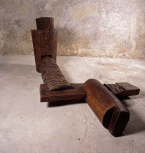
Dragica Čadež
The Story of Wood and Clay
The retrospective exhibition The Story of Wood and Clay, presents an overview of the more than fifty years of creative work by the sculptress Dragica Čadež, who had strongly influenced the Slovene and broader regional cultural space ever since the mid-1960s. The visiting exhibition was originally set up by the City Art Gallery Ljubljana, however, the exhibition in the Božidar Jakac Gallery will include more artworks than the original exhibition, as our gallery has the largest collection of her works from various periods: over 270 statues in total.
The exhibition that will be accompanied by a vast catalogue published by the City Art Gallery Ljubljana, will delve deep into the analysis of the various periods of her work, focus on the continuities and discontinuities that occurred in her creativity, and extract the main emphases of her artistic expression and meaning. Since the mid-1960s, when she participated at the Forma Viva international symposium of sculptors in Kostanjevica na Krki, Dragica Čadež chose to use predominantly wood to express her creativity, however, over the past twenty years or so, she has also started working in clay. The exhibition will thus focus on the various periods of her rich career, in which she, from the very beginning, created in the spirit of high modernism and moved towards spatial sculpture which does not focus on classically centred mass, but rather introduces a rounded sculpting ambience. Dragica Čadež has applied various modernistic traditions to her work, most of which are not linked to the constantly repeated Eurocentric classicism, but feed on cultures found on the outskirts of the artistically dominant milieu, which have never truly became a part of high art in their original form.
Dragica Čadež (1940) graduated from the Ljubljana Academy of Fine Arts (1963), where she also completed her postgraduate studies under professor Boris Kalin (1965). In 1982 she became the first female professor of sculpting in Slovenia and since 1989 she has been employed as a full professor at the Faculty of Education in Ljubljana. She mainly works in wood, but lately she had started working in clay and ceramics, and at various times in her creative past, she had also worked in bronze, plaster and concrete. She has been working and holding solo exhibitions ever since 1963. Between 1968 and 1972 she was a member of the informal group Neo-constructivists (1968-1972), which created geometric and minimalistic art. In 1986 she received the Prešeren award for her breakthrough series of sculptures Associations of Pompei. Dragica Čadež lives and works in Ljubljana.
2020
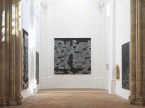
Mitja Konić
Amor Fati
Former Monastery Church, 25. 9. - 6. 12. 2020
In the past years Mitja Konić have taken part in number of group exhibitions across Slovenia but currently he is more present and recognisable internationally. As an artist who lives and works in Munich, he perceives his mission directly from the painting ritual and he creates beyond political divisions, consumer culture, digital media and contemporary trends in visual arts. He focuses on the philosophical and intellectual relationship between human, nature and things. His contemplative artistic language is articulated with formal and semiotic elements while most of his effort is directed at his own artistic typologies.
The exhibition in the former monastery church, in which monumental canvasses prevail, reveals the core of Konić’s poetics. The dominating concept of his understanding of creativity is revealed already in the title of this exhibition and can be seen as the prevailing motif in some of the exhibited works. Konić views all actions between himself and the canvass, between self-reflection and external reality, as fate. He views the entire creative process, starting with the idea, continuing with the thought process, and ending in the selection and combination of materials, as alchemy. The final result is a painting that is a stunning intersection of various worlds, or, one could say, Konić’s intermediary world.
Curator: dr Robert Simonišek
Photo: Jaka Babnik

Silvan Omerzu
A Retrospective
11. 9. 2020 - 8. 2. 2021
Retrospective at the Božidar Jakac Art Museum showcases the overview of artistic career of theatre director, puppet maker, set designer and visual artist Silvan Omerzu. The exhibition showcases extensive and diverse selection of his works, from drawing and painting, shadow image, kinetic sculpture, space installation to set design and puppet, that were created in the past thirty years.
Artistic practice of Silvan Omerzu is characterised by pronounced interdisciplinary approach and he has never tied himself to any particular artistic discipline or medium; instead, he has worked as visual artist, set designer, puppet maker and theatre director simultaneously. In his artistic practice that is being presented in theatres as well as in galleries, he creates complex spatial installations, made out of wood and various other materials, that showcase expressive and often grotesque motifs in which subtle social criticism and gallows humour are reflected. The exhibition will thus showcase selected elements of some of the most renown and crucial pieces such as theatre productions Forbidden Loves (Ljubljana Puppet Theatre, 2009), The House of Mary Our Helper (Mladinsko Theatre, 2007-2008) and Words from the House Karlstein (Maribor Puppet Theatre, 2017), or exhibitions such as Automatons, Puppets, Actors (MGLC, 2010) and Ivan Cankar and Europe (Cankarjev dom, 2018-2019). Moreover, Omerzu has already exhibited at the Tears show in the former monastery church of Božidar Jakac Art Museum in Kostanjevica na Krki which was then transformed into total ambience.
On the occasion of this retrospective an extensive catalogue was published with essays of dr. Nataša Smolič and dr. Blaž Lukan, and with the interview of Marko Bauer. Curator of the exhibition is dr. Jure Mikuž.
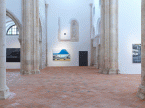
Slobodan Vidović
States
Former Monastery Church, 3. 7. - 6. 9. 2020
Slobodan Vidović (born 1974 in Gradiška, BiH) who is known for his large-format abstract paintings, this time entered a completely different field - the field of digital media, which, reinforced by the information revolution and digital precision transmissions, has been entering the field of painting for more than three decades. Vidović, as written by dr. Nikola Šuica, took contemporary models of visibility that are encouraged by the mixture of reality and lies presented by the media. The understanding of the panopticon of such an unstoppably dynamic world can hardly be recognised without irony. The painted motives emerge from the planetary span, which joins the melancholic feeling of exclusion with its sensibility. The series States brings a precise scope of realistic worlds that have been imagined and passed on through the language of painting structured scenes that are recognisable and perceived in the layering of media fixations. Through the static calmness of the precisely structured motif one can notice a distant trace of the photographic origins that have been transformed through a reduced colour scheme within a selected colour for each painting, at which the layering of paint originated in his earlier abstract series that approached non-abstract unbridled penetration into matter.
The exhibition was prepared in collaboration with Museum of Contemporary Art RS from Banja Luka.
Photo: Jaka Babnik

Solitudes
Expressions of Anxiety in the Visual Arts from the Prekmurje Region
30. 5. - 16. 8. 2020
Igor Banfi, Dubravko Baumgartner, Nikolaj Beer, Robert Černelč, Sandi Červek, Ladislav Danč, Marjan Gumilar, Štefan Hauko, Zdenko Huzjan, Nataša Kos, Franc Mesarič, Mirko Rajnar and Dušan Šarotar.
The exhibition Solitudes. Expressions of Anxiety in the Visual Arts from the Prekmurje Region celebrates the centenary of the accession of Prekmurje and the unification of Slovenians from Prekmurje with their mother nation.
The exhibition deals with the theme of solitude, anxiety and melancholy as common denominators, which were – over the past fifty years - comprehensively expressed by various artists from Prekmurje. By addressing and discussing the horizon, emptiness and melancholy, the exhibition tries to explain the meaning and importance of these terms and establish how they are seen in the works created by the presented artists. At the same time, the exhibition shows that the artistic expression in Prekmurje does not differ from visual arts elsewhere, i.e. it is not an expression that can be noticed solely in this region and nowhere else. The art language and style in which it is expressed, is original and geographically unlimited, which makes it universal as it does not show any local or regional traits.
The goal of the exhibition was to present two segments. One is the high levels of creativity that we have witnessed in Prekmurje over the past fifty years, while the other is the attention to moveable heritage, as all exhibited and presented works come from the permanent collection of the Murska Sobota Gallery. Curator Dr. Robert Inhof has set up the exhibition in relation to the experience of the horizon as a border experience. This experience was interpreted by each individual artist presented in his or her unique way. The experience and the art language of the presented artists are universal.
2019
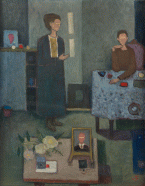
Nande Vidmar
Retrospective
4. 10. 2019 - 15. 3. 2020
Painter, graphic artist and sketcher Nande Vidmar (1899-1981) is considered one of the key personalities in the visual arts in Slovenia in the 20th century. Despite numerous exhibitions and references in literature, he was profoundly introduced to the public only once with retrospective exhibition in the City Museum of Ljubljana (1989). An impulse for the artist‘s most comprehensive presentation untill now, reaches to the year 2017, when preparations for the exhibition Faces of Expressionism began. Mišo Vidmar, his son and owner of majority of artist‘s oeuvre, emphasized the heterogeneity of his father‘s work, such as expressionist, new and social realism artworks that were created during 1920s and 1930s. Furthermore, his paintings and drawings from 1950s and 1960s were tucked away in artist‘s apartment in Ljubljana far from the public eye. They belong to his mature and late phase when he lived in the capital and had withdrawn from society. A picturesque journey organised through exhibition spaces highlights artist‘s immanent characteristics. The core of Vidmar’s interest is human and artist‘s own environment. Both defined his mentality and emotions in different periods of history. The exhibition begins with drawings from his youth from the end of WW I and finishes with his last painting Abandoned Wall (1971).
dr. Robert Simonišek
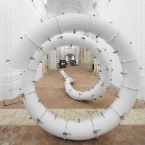
Neven Bilić
Ad infinitum
former monastery church, 13. 9. 2019-9. 2. 2020
In the former monastery church of the Božidar Jakac Art Museum, a Croatian artist Neven Bilić presents his works for the first time to the Slovenian public with a solo exhibition titled Ad infinitum. The exhibition presents works created a decade ago, which, set in the former sacral space, establish new relationships and open new possibilities for their interpretation. The insight into the process of creation is one of the significant moments at which the dialogue between the artist, the work, and the viewer develops. In the process of articulation of artistic ideas, Neven Bilić has shown since the very beginning the sensibility towards non-traditional materials by tirelessly exploring their potential. He therefore experiments with different kinds of polymer, the so-called non-traditional materials, which transform into new shapes, geometric or organic, by applying creative and complex methods, thus revealing the infinite potential of formation. The fascination with various kinds of synthetic materials, the experimenting and detection of the optimal technological method constitute the basic creative principles of Bilić‘s work.
The exhibition was created in collaboration between the Božidar Jakac Art Museum and the Museum of Contemporary Art in Zagreb (Muzej suvremene umjetnosti Zagreb).
Curator: Vesna Meštrić
Photo: Marko Ercegović

Drago Tršar
Monument
18. 5. - 8. 9. 2019
Academic sculptor and academician Drago Tršar is written in the patrimony of Slovenian sculpture as an important figure. His outstanding works, which extend from monumental public to small sculptures, can be found in all publications surveying Slovene fine arts of the 20th century. He is also recognised by works in various other fine arts media. Drago Tršar has also been a longtime professor at the Academy of Fine Arts in Ljubljana. On the occasion of the author’s ninetieth anniversary in 2017 and at the initiative of the Museum of Modern Art, the Božidar Jakac Art Museum joined the inter-institutional project entitled: MONUMENT - DRAGO TRŠAR. A wide-ranging and in-depth professional examination of the author’s oeuvre, executed between 2017 and 2019 by seven museum institutions, resulted in a series of exhibitions across Slovenia, with the final exhibition in Kostanjevica na Krki.
The exhibition in the Božidar Jakac Art Museum, as the last in a series, includes ensemble of works from all creative periods, selected by the author. The layout in six rooms of the exhibition space focuses, in contrast with the layout of the exhibition in the Museum of Modern Art, on the sculptures of smaller dimensions in bronze, plaster and ceramics. The exhibition opens with depictions of the animal world, which is a permanently present theme throughout Tršar’s creative oeuvre, and continues with figural sculptures from his early period. The last room on the first floor is dedicated to the artist’s most recognisable cycle titled Multitudes, which shifts the focus from the field of intimate poetics and moves it to the public sphere. One of the works from this cycle, the Multitude from the 1960’s, comes from the collection of the Božidar Jakac Art Museum.
On the second floor, the exhibition (adapted to the space) continues with ceramic sculptures influenced by Picasso. Ceramics, which accompanied Drago Tršar throughout his artistic career are followed by the cycle of sculptures in bronze titled The Figures Within that redefines the meaning of dualism in relation to individual and the crowd. The space inside the sculptures is in comparison to the Multitude cycle completely different, as it no longer functions as the public space. Drago Tršar is well known as an exceptional portraitist and by this at the same time also as chronist of the 20th century. A selection of portraits concludes the exhibition and draws a comparison and dialogue between unnamed “Multitudes” and figures from a public, more specifically cultural space, who are immanent to the multitudes, yet have through their own actions, deserved to be depicted.
Curator: Goran Milovanović
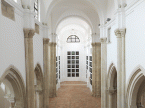
IRWIN
Was ist Kunst Bosnia and Herzegovina / Heroes 1941–1945
Former Monastery Church, 27. 4. - 7. 7. 2019
Most of the portraits of the People’s Heroes from Bosnia and Herzegovina were made by Bosnian-Herzegovinian artists in the aftermath of WWII, and the collection was completed by 1954. Although the idea was to include them in the permanent collection of the Museum of the Revolution of Bosnia and Herzegovina, that was never realised. Instead, the public first saw them in an exhibition in the mid-1950s, after which they were deposited in the museum storerooms, falling into oblivion. Historical Museum of Bosnia and Herzegovina (until 1993 the Museum of the Revolution of Bosnia and Herzegovina) invited the IRWIN collective to help with the preparation and staging of an exhibition of selected works. The collective recognised its qualities and appropriated it to frame a display entitled Was ist Kunst Bosnia and Herzegovina. This is by no means IRWIN’s first project of this kind. In the past the collective have conceived a number of projects, in response to the particular contexts of the selected places and areas with shared common experience of history.
The exhibition was conceived and realised in collaboration with the Museum of Contemporary Art of the Republic of Srpska (Banja Luka) and with the Historical Museum of Bosnia and Herzegovina (Sarajevo).
2018

D K V
Dugo, Kusterle, Valvassori. Three Stories From the Border.
New Gallery, 19. 10. 2018 - 10. 2. 2019
The idea of bringing together three artists, with diverse characters, and very different approaches to their work, dissimilar forms of expression and even understanding of art, but with a shared location of habitat, i.e. in the vicinity of a border, led us to contemplate whether we can compare them and find a shared tension within them and their work, i.e. a desire to see further, beyond the border, which all three artists see as a challenge and thus a reason to expand rather than restrict.
The work of each one of these three artists was juxtaposed in relation to the border on numerous occasions: in his text on France Dugo’s work Marco Goldin mentioned ‘the border as an existential state’; in his thoughts on the artistic development of Giorgio Valvassori, Giorgio Bonomi stated that ‘living and working in an area close to the border has strongly marked his work and life’; in an interview Roberto Kusterle stated that the space in which he lives is important, and he spoke about the ‘strong Central European heritage, a certain type of vision, the use of thick black [...]. The history still runs through our veins’.
The story of Franco Dugo starts with inspiration from the east. At the beginning of his painting and engraving career the painter and graphic artist Jiří Anderle was as much in the artist’s thoughts as Rembrandt. Dugo admires the precision and the callousness of the line with which the Czech artist explored the darkest sides of humanity in a dimension beyond time, and his boldness, with which he revealed the truth in a surrealist manner and without any censorship, which can be unpleasant to say the least. In Rembrandt’s works he observed the technique, the masterful game of light and shadows, the capability of descending deep into the human psyche, all of which Dugo repeated in his work, starting with self-portraits, which have been registering the passing of time throughout his life.
The photography in the work of Robert Kusterle is a means that erases all borders between truth and pretence and mixes them so they can no longer be distinguished; it becomes impossible to say what is real and what is not, as everything has been changed into what could have been. The technique and the contents represent the red thread that connects the work from the previous years with his newest works: the artist shows continuous interest in the relationship between man and nature. Nature finds the artist almost by chance as he strolls along the seashore or along a river embankment. In this case nature is represented by the soil, water, stones and everything that is moved, shaped and changed by water as these changes in the form inspire new worlds and new stories.
Giorgio Valvassori offers a game of opposites, for which he chooses elements, materials and forms that are linked to the essence of geometry and space, fabric and wood, iron and lead. The forms call into mind situations, the objects interact with the space and the viewer, the sculptures and installations encourage a different perception, which destabilises the mind by contrasting the appearance of everyday reality and playing with antimonies, irony and drama, lightness and heaviness, the concept and materiality, with ambiguity in general.
(Franca Marri, from the catalogue to the exhibition)
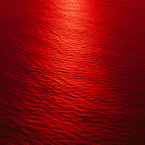
Branko Cvetkovič
NON-SPACE | ZeroSPACE
Former Monastery Church, 21. 9. - 25. 11. 2018
The photographic exhibition NON-SPACE│ZeroSPACE establishes various states which, with photographic crops as momentary brakes, fragment and process the dynamics of time. The sea surface changes into a rhizome surface of endlessly multiplying creases, which transform the topographic preciseness of the shot into an area of contemplation and a symbolic plane of expanding time and infinite space.
In the vast naves of the sacral architecture the seas open a spiritual experience that does not stem from metaphysical implications, but from known phenomena and objects. Beyond the Black Square, in the space of the church choir, the oceanic surface conceptually turns into an empty reflection in the photographic series Dead eyes. In this intimate sanctuary death, landscape and the feeling of holiness become linked and intertwined. The painfully intimate shots of eyes document the absence of the gaze – the contradictory presence of absence – and place us in direct proximity with the distant gaze which arouses discomfort with the vagueness and the alien void. The dead eyes reflect total tranquillity, as if they mirrored the zero space of the tranquil sea surfaces without a horizon. Cvetkovič understands death as “the most elementary abstract notion in the entire structure of human consciousness and as a physical abstract of the non-space and zero time”. This unknown space of the absent consciousness is, as he explains, “the most abstract way of symbolising the human perception of space time and the perception or the incapability of imaging that they do not exist.”
However, the zero space is not merely a space of the ontological end and closure, in the same way as the black in the Black Square is not blindness or invisibility, but a system of dark lights or the glittering of darkness as we know it in certain rare moments when we close our eyes. The notion of the zero space as the antithesis of the space that Cvetkovič follows through the surface and light, is not so much something outside, in the landscape, as it is behind the wall of our eye.
Curator: dr. Nadja Gnamuš
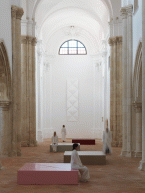
Petra Varl
Near Light
Former Monastery Church, 22. 6. - 26. 8. 2018
The exhibition Near Light emerged from the artist’s minute intimate, sensory and rational impulses to create a dialogue with an extremely enticing and demanding exhibition space. Petra Varl created a spatial choreography between four basic elements, which play with the artist’s and visitor’s experience of material reality and subtly connect it to the possibilities of the fleeting and transient. Through this the space is exposed to suspense between the material and something which is on the edge of the material presence, between the visual and non-visual. We are witnesses to a ‘liberation’ within the exhibition which emerges from combining elements that cannot be formally merged. Rather than with the physical inertia of mass or volume, which would fill the demanding exhibition space, the artist’s individually introduced elements are open and dynamic and try to break down the feeling of weight and volume and in this way show the simple beauty of the void within an architectural space. The exhibition Near Light is not merely a sincere derivation of the artist’s rational thought on the exhibition space, but also an intimate short story which reveals thoughts that are always split between experience and non-experience. The artist’s as well as the visitor’s.
Curator: Tevž Logar
Music: Ólafur Arnalds – Near Light
Clothes designed by: Uroš Belantič
Photocredit: Jaka Babnik

Faces of Expressionism
Božidar Jakac Art Museum, 26. 5.-20. 9. 2018
The exhibition features works of famous authors of German and Czech expressionism, such as Ernst Ludwig Kirchner, Emil Nolde, Karl Schmidt-Rottluff, Käthe Kollwitz, August Brömse, Emil Filla, Josef Čapek, Bohumil Kubišta, Otto Gutfreund and others, which will be placed side by side with works by Slovenian expressionist artists, such as Božidar Jakac, France Kralj, Tone Kralj, Veno Pilon, Fran Tratnik, Nande Vidmar, Drago Vidmar and others.
The exhibition was created in cooperation of Božidar Jakac Art Museum with the GASK - Gallery of the Central Bohemian Region, Kutná Hora (CZ). The exhibition presents works from: Božidar Jakac Art Museum, GASK - Gallery of the Central Bohemian Region, Kutná Hora, IFA - Institut für Auslandsbeziehungen, Kupferstich-Kabinett, Staatliche Kunstsammlungen Dresden, Kunstforum Ostdeutsche Galerie Regensburg, The Museum of Modern Art in Ljubljana, Museum of Contemporary History of Slovenia, The Pilon Gallery, Maribor Art Gallery as well as from private collections.
Curators: Goran Milovanović in dr. Robert Simonišek
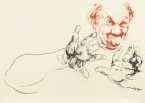
Bojan Golija
A Retrospective
Galerija Božidar Jakac, 3. 2. - 22. 4. 2018
The first major posthumous overview of works by Slovene graphic artist and art educator Bojan Golija (1932-2014) offers an opportunity for a comprehensive evaluation of the artist’s exceptional and varied opus. Studies under the mentorship of Božidar Jakac, and a formative journey to Japan in 1957, inspired a life dedicated to the explorations of the possibilities of graphic arts, and devoted to visual arts education at the Faculty of Education at the University of Maribor.
The exhibition was created by Umetnostna galerija Maribor in cooperation with the International Centre of Graphic Arts in Ljubljana, University of Maribor and Faculty of Education at the University of Maribor.
2017
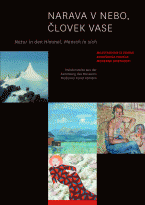
Nature to the Sky, Man to Himself - Masterpieces from the collection of the Carinthian Museum of Modern Art, Klagenfurt
Božidar Jakac Art Museum - New Gallery, 13. 10. 2017 - 7. 1. 2018
The exhibition Nature to the Sky, Man to Himself is an interactive combination of Austrian (post)modern painting and contemporary literature. The selection of landscapes and figural paintings, predominantly portraits, includes the key representatives of the Austrian painting pantheon of the 20th century, such as Herbert Boeckl and Maria Lassnig as well as the individual and diametrically opposed Werner Berg and Arnold Clementschitsch. The first part of the exhibition focuses on Marko Pernhart, the first Slovene realistic landscape painter. The depictions of nature and man are combined by quotes by numerous poets and writers from Carinthia and the broader Austrian milieu, including Valerie Fritsch, Alexander Peer, Gabriele Kögl and Maja Haderlap. Nature to the Sky, Man to Himself motivates the visitor to create personal stories on the image-text relations and question the relationship between man and nature, history and personal experience, the bodily and the spiritual, the province and the centre. At the same time it is a panoramic overview of the major periods, orientations and movements in 20th century Austrian painting.
Alongside the Carinthian Museum of Modern Art in Klagenfurt, from where the canvasses originate, the following institutions participated in the exhibition: Robert Musil Literature Museum, The Slovene Writers’ Association in Austria, Carinthian Writers’ Association and the Austrian Cultural Forum.
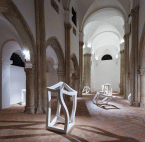
Alem Korkut
Corpus
former monastery church, 7. 10. 2017 – 07. 01. 2018
In all respects in which the concept of the body is used (anatomy, geometry, oenology, politics, esoteric) the body represents a synonym for stability, strength and reliability. The sculptures in this exhibition entitled Corpus, which stem from basic geometrical forms (cubes, parallelepipeds), also lean upon these characteristics. However, similar to wine which loses its aroma through time, the physical body loses its firmness and strength. In the political sense the body is thus revealed and starts losing its reliability and clear contours, it no longer provides support, it starts to disappear, melt away.
Alem Korkut (1970) studied sculpture at the Academy of Fine Arts in Sarajevo and Zagreb, where he graduated in 1997. From 1998 to 2007 he was a member of Croatian Freelance Artists Association. He has been a member of the Croatian Association of Artists since 1998. Since 2007 he has been an Associate Professor at the Academy of Fine Arts in Zagreb.

Tina Dobrajc
Big Girls Don't Cry
former monastery church, 19. 5.-10. 9. 2017
Slovene artist Tina Dobrajc in her solo exhibition titled Big Girls Don’t Cry, presents recent paintings and multimedia works, focused on the current political situation, the national mythology and gender issues. On her canvases, in mixed techniques, the artist depicts imaginary places and scenes that serve as a metaphor for everyday phenomena in the world that surrounds and leaves its marks on her.
The exhibited works are unique allegories of the present moment and can be understood both particularly and universally, as they apply to local as well as global socio-political situation. On the one hand, the artist explores themes of national and cultural identity, which is becoming an increasingly hot topic of public discourse in the European countries; on the other hand, she focuses on the role of women in these societies, which are torn between the desire to preserve tradition and the inevitability of progress. The idea to preserve existing prosperity brings with it numerous consequences, which are often in conflict with hard won civil rights of different social groups. The works of Tina Dobrajc are often based on selected fragments of everyday life, which, in its distortion, absurdity and irony, are becoming grim witnesses of some of the most crucial social phenomena of the given moment. (Miha Colner)

Dušan Tršar
Retrospective
Božidar Jakac Art Museum - New Gallery, 31. 3.-20. 8. 2017
A retrospective exhibition, which was prepared on the occasion of the artist’s life jubilee – 80th birthday, presents the most important works from his opus, which has been created over more than sixty years. A chronologically conceived layout presents in the first section Tršar’s earliest works from the first half of the 60s, formed in plaster, terracotta and lead, which the artist created after he had finished the Academy of Fine Arts. These were followed by works in welded iron, in which the artist shifts from realistic manner to the creation of more and more schematic forms of the human body. In the second half of the 60s the artist creates silhouettes made of wooden lamellas, wire and iron rods, which are bent at the upper end and thus preserve the memory of the human form.
The 70s are marked by sculptures made of fluorescent Plexiglass, which the artist illuminated by neon light. The design of his objects and a cold industrial character of the chosen material are enriched by the use of colour, which becomes an autonomous artistic element. In this period Tršar joined a group of young Slovenian artists called “Neo-Constructivists”. The group originally consisting of Dušan Tršar, Dragica Čadež, Drago Hrvacki and Tone Lapajne was later joined by Vinko Tušek and Slavko Tihec. The group shared the methodological approaches related to the construction of spatial structures and constructivist and minimalist design principles, as well as their fondness for modern materials. Since the second half of the 70s, the sculptures are becoming monochromatic, which is emphasizing the transparency of the works and permits a viewer to look through them. The final stage of this artistic period is represented by works in which the Plexiglass frame is filled with glazed baked clay or bronze forms, which are gradually outweighing the Plexiglass.
A relationship between the sculptor and the matter consumes the artist, who is creating almost entirely in bronze, from the 90s onwards. His sculptures, in which we can recognise flora and fauna forms, vary from small to monumental dimensions. In Tršar’s sculptures one can certainly feel a certain measure of intimate symbolism. The subtlety of the modelling establishes a special relation with the picturesque surface, which can be seen in the delicate play of light and shadows. The forms captured in bronze are permeated with distinct original poetics, which speak to us of eternity and timelessness.
2016
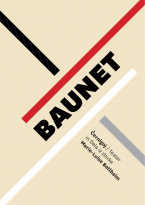
BAUNET
Černigoj / Theatre and Works from the Marie-Luise Betlheim Collection
Božidar Jakac Art Museum, 24. 09. 2016 – 02. 01. 2017
Throughout the history of pedagogical processes it is difficult to find a project that would encompass in practice and in more complexity the concepts and educational methods tailored to
suit human needs, as it was in the case of the Bauhaus. In just fourteen years from its foundation, the Bauhaus became much more than a school. It became a humanistc model for the future, which is far from being exhausted, even though it will soon be over 100 years since its beginning. Walter Gropius was not only a founder of the Bauhaus, but is also considered by many to be one of the founders of modernist architecture. As the authors from the Bauhaus fall within the same time frame as the pioneers of Slovenian Expressionism, whose art collections are being kept and presented in the Božidar Jakac Art Museum, we are delighted to have the possibility to combine and present in our new exhibition area the exhibition Černigoj / Theatre from Škofja Loka Museum and works from the Marie-Luise Betlheim Collection, which were part of a large exhibition Bauhaus – Networking Ideas and Practice (BauNet) in the frame of international research project BauNet, organized by the Museum of Contemporary Art in Zagreb. In this way the Slovenian artist August Černigoj (1898 Trieste - 1985 Sežana) is put into context of active Bauhaus artists, during the period when he himself had intensive contacts with this influential school.
The international research project BauNet was created in collaboration with four partners: the Museum of Contemporary Art Zagreb (a project promoter), the Universalmuseum Joan-
neum from Graz, the Academy of Fine Arts Sarajevo and the Škofja Loka Museum. The aim of the project was to thoroughly research and present the activities and interaction between the artists from the south-eastern region of Europe, who studied at the renowned international school for architecture, design and visual arts – the Bauhaus, their impact and influence on artistic practices in the south-eastern region of Europe in the fifties and on the legacy of avant-garde movements. The BauNet project was supported by the EU Culture Programme 2007–13.

Ana Pečar
Serene Chorus
Former Monastery Church, 08.07.2016 - 29.08.2016
The work of Ana Pečar traces the hidden layers of an ancient knowledge. The present corpus of video works and photos pulls its inspirations from textual and visual materials collected by Pavel Medvešček, more precisely from testimonials of the Old Faith among the Slovenes living in the Posočje region. The selected recording locations trace the sites presented in the narratives. The ambience of The Spring of St. Mary Monastery in Kostanjevica resonates the watery essence of the Krka river surroundings. Drawing from the old layers of culture, which are mostly related to sexuality and fecundity, the spring, understood as Mary’s attribute, acts as the pivot for the available, refreshing, living water, indispensable for life and prosperity. The author has created an atmosphere that rouses the inherent forces of the landscape, challenging us with pulsations of a suggestive, golden glow of water. Artistic focus is on water in its dimension as the medium of light. It seems to be a magical mirror: despite allowing the gaze to penetrate it quite smoothly, it nevertheless spherically mirrors up and down and all the in-between layers on the light-shadow spectrum, materializations of a co-movement visible to the eye.
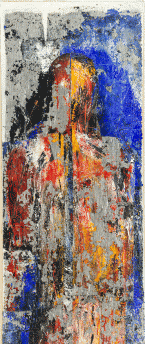
Valentin Oman
Retrospective
Božidar Jakac Art Museum, 06.05.2016 - 28.08.2016
This retrospective offers a review of Valentin Oman’s work over the past fifty years. Oman‘s impressively extensive oeuvre concentrates predominantly on painting and graphic arts, with particular emphasis on intricate, experimental expansion and combination of these artistic resources; his themes are human existence and the question of being, transience and transcendence. He has developed a distinctive pictorial vocabulary centered on the human figure and realized in exceptional techniques and evocative materials that formulate the figure as a symbol of a self-transcending metaphysical dimension. It appears, apart from traditional graphic works, in complex murals, material pictures and collages, and sculptures of metal and glass. This exhibition has collected examples ranging from the 1960s to today, including works from the Hermagoras Collection and the Carinthian Museum of Modern Art (MMKK); there is also a variety of travel sketches and landscapes, documentations of his countless works for public space, and an installation referring to his commitment to bilingual place-names in Carinthia – a particular concern of his, since he belongs to the Slovenian ethnic group.
Showing subsequently in the Carinthian Museum of Modern Art, the Vienna Künstlerhaus and the Božidar Jakac Art Museum, the exhibition is accompanied by a publication of 226 pages, with copious illustrations and essays by Martin Traxl, Milena Zlatar and others, in German, Slovenian and English.
Christine Wetzlinger-Grundnig, MMKK
2015
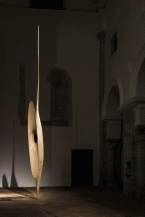
Mirko Zrinšćak
Sculptures
Former Monastery Church, 10.04.2015 - 20.07.2015
Mirko Zrinšćak (1953, Volosko, Croatia) has placed nine monumental wooden sculptures – whose pronounced verticals create subtle effects – in a dialogue with the space represented by the former monastery church. In the right light, these sculptures appear to float in space. In terms of content, the works are a continuation of the exploration of sculptural form begun by the artist in 2008 with the installation of his exhibition Forms of Space in Zagreb’s Art Pavilion. The artist continues his search for the ideal form, which in his words is a sublimation of all forms of his own personal archipelago, in the former monastery church in Kostanjevica na Krki. This search should be understood as the artist’s intimate meditation and search, which in Zrinšćak’s case is not a method but rather derives directly from his way of life, wholly dedicated to sculpture. This is why we can also understand Zrinšćak’s sculptures in the field of the sublime as an artistic statement based on experience. Any kind of insight requires profound attention from the viewer, a kind of haptic state in which an instinctive desire for tactility appears, when in the silence we start to pick up vibrations that we then feel somewhere in our gut, and hear the sounds of timelessness, when from far back in the past we also hear the here and now.
2014
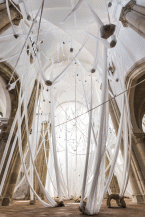
Milan Erič and Zvonko Čoh
Yearning for Light
Former Monastery Church, 23.05.2014 - 31.08.2014
As artists, Milan Erič and Zvonko Čoh particularly excel in the medium of drawing. The exhibition in Kostanjevica, entitled Yearning for Light, betokens a shift in their work from drawing installations featuring unusual, clever and even improvised combinations of drawings that take shape through a dialogue with the space to installations in space. The installation at Kostanjevica is a comprehensively formulated ambience inspired by the architectural and symbolic logic of the space; at the same time, as an art intervention it subverts it and translates it into a different experiential zone. In the space of the monastery basilica, the artists created an alternative architectural situation by hanging and unfurling translucent white strips from the ceiling and walls. It is as if they are drawing on air. Forming a meshwork, the strips fill out and set in motion the otherwise vacant church space. On the one hand, their structure keeps time with the rhythm of the architectural elements: the pointed arches and the sheaf-like columns and arcades; on the other, it retains its own unique interplay of forms.
Photo: Tomaž Grdin
2013
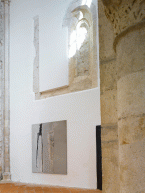
Marjan Gumilar
Focusing
Former Monastery Church, 18.05.2013 - 27.10.2013
What does the Marjan Gumilar exhibition at the Kostanjevica church show and tell us?
Stations of the Cross in painting. The process of how a painting goes through phases of suffering, cutting and torture, so that only through extreme reduction, on the verge of abstraction, does it achieve a sublimity that is a match for the times, that climbs upon the altar and goes beyond.
In order to reduce the painting to its fundamental components, Gumilar does not need to cut it or multiply it, for indeed its Stations of the Cross are evident within the painting. Then the process that can already be perceived within the individual painting is then externalised into the space and divided into individual sequences. At the moment when you put together (more than) two paintings, when you initiate (at least) two cuts, you are not faced simply with the issue of the spatial neighbourhood (left, right) and temporal sequence (before, after), but primarily and firstly with the issue of beyond: physics is hollowed out by metaphysics, the world can find in itself the cut to the sacred.
On the empty altar of the Kostanjevica monastery church, Marjan Gumilar’s paintings are reduced to their fundamental components: black, white, brush stroke, plane, light, glint – and our view. The church is turned on its head here, since in the holiest place of its rituals it does not place god-the artist, but the believer-viewer.
Photo Damjan Švarc
2012
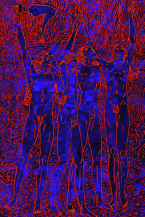
Tomislav Buntak
A Journey of Encouragement
Former Monastery Church, 25.05.2012-04.03.2013
Tomislav Buntak (1971, Zagreb, Croatia) — academically trained painter and lecturer at the Painting and Drawing Department of the School of Arts in Zagreb. He is considered to be an idiosyncratic artist and a representative of the almost forgotten genres of fantastic realism and symbolism, due to his complete dedication to traditional artistic disciplines, representation and exotic themes. His cycle of monumental drawings, A Journey of Encouragement, unorthodoxly interpreting biblical themes in fluorescent colours within the baroquified romantic architecture of the desecrated former church, is a glorious example of his trans-generational, trans-culturological and trans-religious creation.
2011
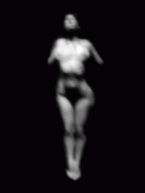
Uroš Abram
Body. Made in me
Former Monastery Church, 30.9.2011 - 18.3.2012
‘Body. Made in me’ exhibition tackles the „irony of the industrially produced commodities for mass consumption, marked with the tag of origin. It emphasizes the uniqueness and unrepeatability of the image whose creation Abram personalized to the extreme limit and at the same time managed to avoid the aura of Art, the mythization of creativity; the image of the body even in my own body remains the product of pure optics in combination with chemistry. This has been achieved by Abram improvising the camera obscura in his mouth thus changing his very mouth into a photographic device which we might want to call camera oralis. The traces if incidences left by the process on the little piece of photosensitive paper became the constitutive parts of the image,“ as observed by Andrej Smrekar, PhD, who contributed opening introduction and essay accompanying the catalogue.
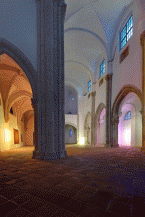
Zmago Lenardič
Second Life
Former Monastery Church, 20.05.-28.08.2011
Zmago Lenárdič (born in1959 in Ljubljana), academic painter, Professor at the Academy of Fine Arts and Design, Ljubljana, presented his work at the site-specific exhibition in the Former Monastery Church, entitled Second Life.
In its very title, the Second Life exhibition takes us on the road of the Internet and its virtual possibilities. Specific expression of the artist’s visual poetic is rooted in the tradition of Modernist Art. In the exhibition installation we follow his investigation of the painting as an object and perception of a visual field – the subjects that essentially occupy him throughout his career. The artist introduced the vibrancy of stained glass windows into the abandoned colourlessness of the church.
2010

Mirko Bratuša
Hypocrites
Former Monastery Church, 17.09.2010 - 12.12.2010
Mirko Bratuša has prepared an exhibition for the gallery in Kostanjevica, housed in the former monastery church, and called the sculptures Hypocrites. In the case of the artist who is sensitive to the subtlest nuances of the spaces for which he prepares his exhibitions, the choice of theme was certainly dictated by the energy written into the church by time and the purpose for which it was built. But as it is generally characteristic for his work, he has not submitted to the usual, majority conception of this once-sacred space and instead has intuitively sensed its numerous other functions and, with his inexhaustible imagination, impressed them on the Hypocrites.

Bojan Gorenec
Diverse entrances – second line
Former Monastery Church, 7.5.2010 - 22.8.2010
Site-specific installation presented artist whose painting work has from the very beginning been based on reflecting and examining the medium, its potential for expression, medium specifics and the issue of representation or the emergence of the image. Essay accompanying the catalogue had been contributed by Tomislav Vignjević, PhD, the exhibition’s curator.
Bojan Gorenec graduated at the Academy of Fine Arts in Ljubljana in the class of Prof. Marjan Pogačnik and Prof. Jože Brumen in 1979. He had been awarded the Prešeren Foundation prize in 1990.
2009
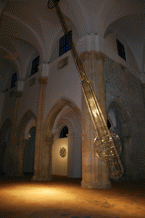
Petar Barišić
Barišić's pendulum
Former Monastery Church, 18.09.2009 - 29.11.2009
„The mind set and art of the Middle ages have always been discretely present in Barišić‘s works. In his early sculptural accomplishments, he evoked romantic art and now, after almost two decades of dealing with the form reduction and the problematic of geometrical forms, he found himself once again in the medieval space ...“ as exhibition’s curator Mladen Lučić observed in an essay accompanying the catalogue and at the exhibition opening.

Mojca Zlokarnik
Glowing
Former Monastery Church, 05.06. 2009 - 23.08. 2009
When Zlokarnik exhibits paintings full of primary colourfulness, they are a contribution from an artist who is experiencing intensively current times and pondering them deeply, while at the same time she is emotionally observing and grasping history. In this way she recognises that each colour is a self-aware personality with an extraordinarily rich and changeable physical, spiritual and symbolic past,“ as exhibition’s curator observes in the essay accompanying the catalogue.
Opening programme featured opera singer Zdenka Gorenc, accompanied by pianist Nataša Valant.
2008

Robert Šimrak
Wireframe
Former Monastery Church, 19.09.2008 - 30.10.2008
Inside the Gothic Church, Šimrak placed nine translucent objects, introduced by 10-meter long digitally printed sheet in presbytery. The 10 objects are entitled ‘Cybermachine’, with the subtitle ‘Corps sans organe (body without organs). Exhibition can be attributed with exceptional subtleness and up-to-datedness in the present era. According to many theoreticians, the present era is strongly marked by transition from industrial to information society .

Sandi Červek
Black light, light blackness
Former Monastery Church, 23.05.2008 - 17.08.2008
In the observation of exhibition’s curator Robert Inhof, director of Gallery of Murska Sobota, who had contributed the essay accompanying the catalogue, the artist „carefully considered set-up where the sacrality of the space and the sacrality of his black paintings would be mutually supportive“.
2007
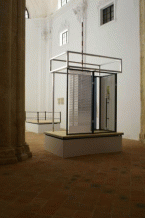
Roman Makše
To Hear / Archisculptostructions
Former Monastery Church, 20.09.2007 - 17.03.2008
As art critic Marko Košan observes in the essay accompanying the catalogue, „the monumental interior of the Kostanjevica church, Makše’s modular units call to mind associations with quasi-utilitarian architectural ‘non-spaces’: bus-stops, phone booths, prefabricated pergolas, summer-winter gardens – constructed passageways, which accentuate the divide between the ‘outside’ and the ‘inside’ … They are like materialised spiritual homes of tomorrow’s earth dwellers ...“
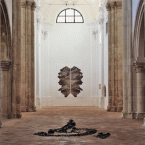
Jože Slak
Skeletons
Former Monastery Church, 25.05.2007 - 26.08.2007
In this site-specific installation, Slak used „the principle of unified spatial design, and with his relief and colours, which introduce a specific pulsation into the constructed ambience, he achieved a unique atmosphere inspired by the culture of the Far East and, last but not least, filled the sacred space with energy,“ observed exhibition’s curator Barbara Rupel in the essay accompanying the catalogue.
Opening programme featured members of the SEATA music band: Aleš Gasparič/ flute and whistle, Lado Jakša/ blowpipe in keyboard, Boštjan Perovšek/ computer and ambiental sound, Jože Slak/ percussion in Miloš Bašin/ percussion and traditional instruments.
2006
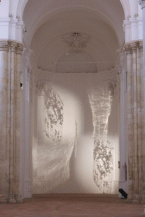
Uršula Berlot
Transitoriness
Former Monastarey Church, 06.10. 2006 - April 2007
In her site-specific artistic installation Uršula Berlot studies the behaviour, response and perception of the viewers in the exhibition space and encourages associative games with the help of the organic shapes produced by reflections of light through compositions on transparent supports.
Essays accompanying the catalogue had been contributed by Barbara Rupel, who also curated the exhibition, and Nataša Petrešin.
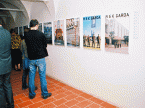
Group Exhibition
Not-completely Non-real: histories, bodies and concepts in contemporary photography
Former Monastery Church, 15.09. 2006 - 16.09. 2006
Exhibition had been a part of SPOT 2006 project, a result of collaboration between House of Photography – Slovenia, Republic of Slovenia Public Fund for Cultural Activities and Božidar Jakac Art Museum. Exhibition had been curated by Marina Gržinić and producted by House of Photography. Participating artists: Tomaž Gregorič, IRWIN, Jane Štravs and Aleksandra Vajd&Hynek Alt.
Exhibition took place in eastern wing of the Božidar Jakac Art Museum’s first floor.
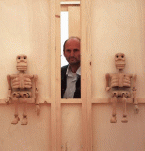
Silvan Omerzu
Tears
Former Monastery Church, 26.05.2006 - 03.09.2006
Site-specific installation of the artist who ‘combines all possible scenic, artistic and theatrical elements which thus affect our senses in synaesthesia.’ Essay accompanying the catalogue had been contributed by Jure Mikuž.
2005
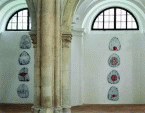
Tanja Špenko
New extensions
Former Monastery Church, 16.09.2005 - 30.04.2006
Exhibition of pictorial objects. Dr. Jure Mikuž wrote in exhibition catalogue: “The latest paintings of Tanja Špenko each communicate on their own, but even more convincingly if they are taken in a series, as arranged in the gallery space of the Kostanjevica church.”

Nataša Prosenc
Crossing
Former Monastery Church, 17.06. 2005- 28.08. 2005
Video installation in the Former Monastery Church. Following the Holly Willis’s essay accompanying the catalogue, „Prosenc suggests the mutability of the body’s boundaries, inviting us to understand a sense of self that expands beyond the confines of somatic limitation.“
2004
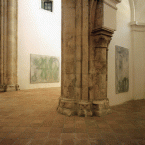
Tugo Šušnik
Former Monastery Church, 24.09. 2004 - 27.03.2005
Painting exhibition in the former monastery church, dedicated to the academic Tomaž Brejc. Essay accompanying the catalogue had been contributed by Tomislav Vignjević, PhD.
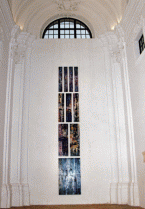
Jože Marinč
The traces
Former Monastery Church, 02.07. 2004- 05.09. 2004
Site-specific installation of artist’s recent paintings. In presented series, „Marinč submitted his conception of the installation to the original function of the sacred space, he made use of the medieval eschatological organization of spatial experience“, as Andrej Smrekar, curator and author of accompanying essay in the catalogue, accentuated. The blue-lavender segment of the colour circle that dominates in the installation components elicits a more spiritual effect.
The opening programme featured All Capone Štrajh Trio.
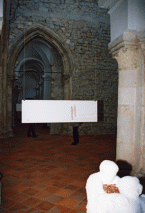
Jiri Kočica, Žiga Okorn
Addressing the freedom of the other
Former Monastery Church, 07.05. 2004 - 27.06.2004
Engaged, site-specific installation of artistic tandem who have been exhibiting together ever since their student years and the consequent graduation in 1991, which entailed a public painting and sculpting event at the Tivoli Park pond in Ljubljana. Opening introduction and essay accompanying the catalogue had been contributed by art historian Vojko Urbančič, the exhibition’s curator. During the exhibition, artists performed Workshops which had been taking place throughout May 2004.
2003
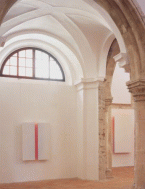
Oto Rimele
Illuminations
Former Monastery Church, 05.09.2003 - 30.03.2004
As director of Maribor Art Gallery and exhibition’s curator Meta Gabršek Prosenc put it in the essay accompanying the catalogue, Rimele’s paintings act as ‘light chasers’.
The opening programme featured cellist Karmen Pečar.
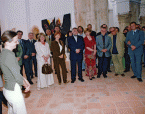
Edo Murtić
Former Monastery Church, 04.05.2003 - 07.07.2003
The display features works by Croatian painter, made between 2000 and 2002. Some of the works had been influenced by the specific site of a Former Monastery Church. Essays accompanying the catalogue had been contributed by Zoran Kržišnik and Katja Ceglar. The exhibition opened in the presence of Stipe Mesić, president of Croatia, and Croatian prime minister Ivica Račan. Official opening speeches were held by Minister of Culture of Republic of Slovenia Andreja Rihter and Minister of Culture of Republic of Croatia Antun Vujić.
The accompanying programme of the opening featured mucisians Igor Lunder with Reeds and Tamara Obrovac with Ante Gelo.
2002
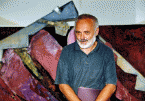
Emerik Bernard
Coincidences
Former Monastery Church, 30.07.2002 - 30.10.2002
Site-specific painting exhibition in Former Monastery Church. Works had been introduced by curator Andrej Medved, PhD.
2001
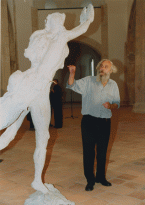
Jakov Brdar
Cobalt blue, green, ochre
Former Monastery Church, 21.09.2001 - 31.03.2002
Specific set-up inside the Former Monastery Church and at the courtyard of the Božidar Jakac Art Museum. Texts in the exhibition catalogue were written by Andrej Medved, Miklavž Komelj, Vesna Velkovrh Bukilica and Bryan Lauch. At the opening of the exhibition, the author and his work were introduced by Andrej Medved.
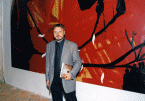
Jožef Muhovič
On transitoriness
Former Monastery Church, 25.05.2001 - 26.08.2001
An exhibition of paintings, drawings and sculptures. The catalogue text is written by Gorazd Kocjančič, a philosopher and translator from classical and modern languages. The catalogue is accompanied by the essay written by Igor Zidić. The opening of the exhibition featured Drago Arko on violin.
2000
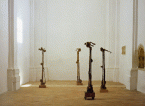
Dušan Tršar
Former Monastery Church, 22.09.2000 - 03.04.2001
Exhibition of sculptures. In the essay accompanying the catalogue, Nadja Zgonik, PhD describes them as „tiny, marginal themes; the shapes of statues are reminiscent of the plant and animal world ...“. Accompanying programme featured Ljubljana Octet, conducted by Igor Švara.
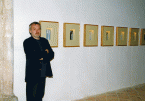
Žarko Vrezec
Relics, paintings 1999 / 2000
Former Monastery Church, 07.07.2000 - 04.09.2000
Exhibition of works, made in recent two years. As Nadja Zgonik observes in the essay accompanying the catalogue, „ the new miniature works of art are the logical continuation of Vrezec’s exploration of small composite entities“.
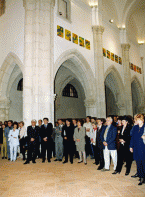
Vatroslav Kuliš
Series 50.5 / 65 / 148
Former Monastery Church, 04.05.2000 - 12.06.2000
In his site-specific installation, Vatroslav Kuliš „considered the given exhibition space as a dynamic space of meaning, as well as the possibility for a highly relaxed formal play of colour textures,“ as observed by Marko Košan in an essay accompanying the catalogue. In the presence of Culture Minister RS Jožef Školč, Anton Vujić, PhD, Culture Minister of Republic of Croatia, officialy opened the exhibition. Accompanying programme featured Zagreb Quartet.
1999
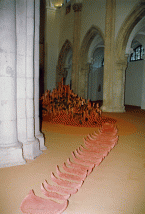
Mirsad Begić
Preserving Dreams
Former Monastery Church, 08.10.1999 - 26.03.2000
Site-specific installation in the Former Monastery Church „is a continuation of Begić‘s interventions in the same site. The Whole, presented in this site-specific installation in numerous details, linked to the reliefs on the wall; captured in eloquent, yet timeless, web of red dust on the Church floor,“ as observed by exhibition’s curator Andrej Medved.
Opening speech had been delivered by the Minister of Culture RS, Jožef Školč.
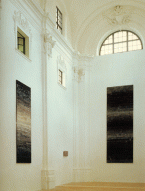
Ivo Prančič
Untitled
Former Monastery Church, 02.07.1999 - 31.08.1999
Site-specific installation by academic painter who graduated in the class of Professor Gustav Gnamuš at the Academy of Fine Arts. Under the mentorship of Gnamuš, he also completed his Master studies. Opening introduction and essay accompanying the catalogue had been contributed by the director of Slovene National Gallery, Andrej Smrekar PhD. Accompanying programme featured Volodja Balžalorsky / violin and Igor Saje / guitar, performing works by Vivaldi, Iberto and Paganini.
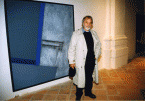
Bogdan Borčić
From the studio
Former Monastery Church, 07.05.1999 - 20.06.1999
Borčič‘s latest series of paintings, in the opinion of exhibition’s curator Jure Mikuž, “fuses life experiences and conveys them through a large theme of the space in which he has spent a major part of his life”. The opening programme featured harpist Mojca Zlobko.
1998

Group Exhibition
The 5th Biennial of Slovene Graphic Arts: American Graphic
Former Monastery Church, 01.10.1998 - 30.11.1998
Exhibition of American Graphic entitled Turning the Century accompanying The 5th Biennial of Slovene Graphic Arts.
Exhibition took place in eastern wing of the Božidar Jakac Art Museum’s first floor.

Lujo Vodopivec
Former Monastery Church, 25.09.1998 - 02.11.1998
Sculpture exhibition. Opening introduction had been contributed by Marko Košan. Accompanying programme featured saxophonists Aleš Suša and Lovro Ravbar.
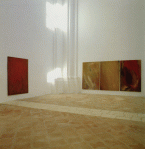
Zdenko Huzjan
Vita Peracta
Former Monastery Church, 08.05.1998 - 31.08.1998
Exhibited Vita Peracta cycle „is thematically based on Huzjan’s concerns with philosophy of personalism“ observed exhibition’s curator Katja Ceglar. Essays accompanying the catalogue had been contributed by Katja Ceglar and Marko Košan.

Barbara Jaki Mozetič
Impression of wealth: 17th century stucco in Slovenia
Former Monastery Church, 27.03.1998
Guest exhibition, prepared by Slovene National Gallery. Accompanying programme featured Mojca Zlobko / harp.
1997

Matjaž Počivavšek
Former Monastery Church, 12.09.1997 - 12.10.1997
Exhibition of sculptures. The artist had been introduced by Andrej Smrekar, director of Slovene National Gallery, exhibition’s curator and author of the accompanying essay in the catalogue. The opening programme featured wind trio Slowind.
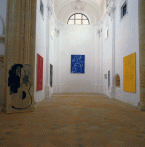
Branko Suhy
From the Spanish palm series 1994-1997: paintings, drawings, prints
Former Monastery Church, 12.06.1997 - 24.08.1997
Joint project of the Božidar Jakac Art Museum and the Coastal galleries, Piran.
The exhibition took place at four different sites: Former Convent Church and Lamut’s Art Salon of Božidar Jakac Art Museum, Piran Town gallery and Meduza gallery in Koper. The artist had been introduced by Bojan Božič, director of Božidar Jakac Art Museum, Andrej Medved, art director of the Coastal Galleries, Pira, and Prof. Konrad Oberhuber, director of Albertina, Vienna. The opening programme featured Vienesse violinist Victoria Marino.
1996
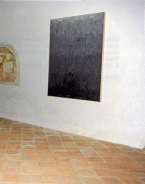
Zlatan Vrkljan
Former Monastery Church, 04.10.1996
Exhibition of most recent landscape paintings by Croatian painter. Opening introduction and essay accompanying the catalogue had been contributed by Vladimir Maleković, director of Muzeum of Arts and Crafts, Zagreb. Accompanying programme featured Studenček Octet from Celje.
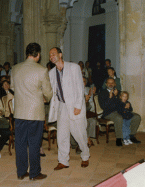
Andraž Šalamun
Former Monastery Church, 06.09.1996
Exhibition presented the most recent landscape paintings which could be, in the opinion of exhibition’s curator Andrej Medved, characterised as „artistic screens, in which the creativity of work seeks a new paysage, long lost to the modern“. The exhibition is a result of collaboration between Božidar Jakac Art Museum and Piran Coastal Galleries. Opening introduction had been contributed by Andrej Medved. Accompanying programme featured Mojca Zlobko / harp.
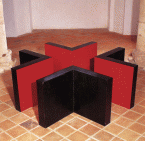
Dragica Čadež
Former Monastery Church, 21.06.1996
Retrospective exhibition. Opening introduction and essay accompanying the catalogue had been contributed by Lev Menaše, PhD. Accompanying programme featured members of wind instruments Quintet Dolenjska.
1995
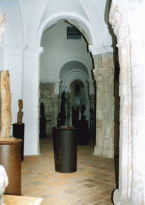
Stane Jarm
Former Monastery Church, 29.09.1995
Exhibition presented wooden sculptures by artist which sculptural oeuvre „is produced on a double margin: in the contemplative (self) isolation and in a continuous, often bitterly accentuated dialogue with his social environment,“ as remarked by Ivan Sedej, PhD, the author of essay accompanying the catalogue. Accompanying programme featured Ljubljana Saxophone Quartet: Primož Flajšman, Betka Kotnik, Jure Cizej and Aleš Suša.

Jona Gal Planinc
Former Monastery Church, 30.06.1995 - 31.08.1995
Exhibition presented works by young artist. Opening introduction and essay accompanying the catalogue had been contributed by Milček Komelj, PhD.
1994

Rihard Jakopič
This is me, the artist
Former Monastery Church, 26.06.1994
Museum and gallery installation of works by Rihard Jakopič, curated by Dragica Zadnik Trobec, Janez Kos and Andrej Smrekar. Installation created by Dušan Kramberger. At the opening, the museum-related work had been introduced by Gregor Moder and Dragica Zadnik Trobec, while Andrej Smrekar held the presentation of the gallery-related involvement.
Exhibition took place in eastern wing of the Božidar Jakac Art Museum’s first floor.

Valentin Oman
Most recent works
Former Monastery Church, 26.06.1994
By exhibition’s opening, The Božidar Jakac Art Museum celebrated Statehood Day. Official opening speech had been delivered by the director of Slovene National Gallery, Andrej Smrekar, PhD. Accompanying programme featured MPZ Brestanica, conducted by Janko Avsenak.
1993

Tone Lapajne
Soil on jute 1992-1993
Former Monastery Church, 24.07.1993
Exhibition marked the occasion of artist’s 60th anniversary. Accompanying programme featured Ljubljanski madrigalisti choir, conducted by Matjaž Šček.
1990
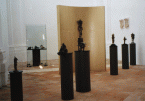
Janez Boljka
Former Monastery Church, 14.07.1990 - 31.12.1990
Retrospective exhibition had been officially opened by the President of Slovene Parliament, Milan Kučan. Artist had been introduced by director of City Art Gallery Ljubljana, Aleksander Bassin. Accompanying programme featured Chamber Orchestra: Sabira Hajdarević (alto), Jurij Reja (tenor), Tone Grčar (trumpet), Tibor Kerkeš (tromba) and Borut Lesjak (keyboards) performing works of Darijan Božič Intrada 90 and Pagan Hymn, both written especially for this occasion.
1987
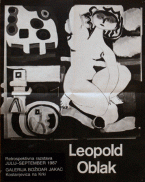
Polde Oblak
Retrospective exhibition
Former Monastery Church, 26.06.1987
Exhibition presented works by the artist who, after graduating from The Academy of Fine Arts, Ljubljana, went to live and study in Munich. Essay accompanying the catalogue had been contributed by art historian Franc Zalar. Opening speech had been contributed by Matjaž Kmecl, PhD.
Accompanying programme featured Slovene Octet performing programme of renaissance, spiritual and folk songs.
1986

France Slana
Former Monastery Church, 24.10.1986 - 30.11.1986
Oil painting exhibition celebrated painter’s 60th anniversary. Artist and his work had been introduced by art historian Janez Mesesnel. Exhibition had been opened by president of the SRS assembly Miran Potrč. Accompanying programme featured APZ Tone Tomšič, conducted by Jernej Habjanič.
In the photo: France Slana and Igor Torkar.

France Gorše
In memoriam France Gorše 1897-1986
Božidar Jakac Art Museum, 05.08.1986 - 17.08.1986
Exhibition presented works, donated to Kostanjevica na Krki and its people by the artist.
Works had been presented on the arcade corridors of Božidar Jakac Art Museum.
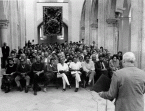
Jože Horvat Jaki
Tapestries
Former Monastery Church, 13.06.1986 - 30.09.1986
Exhibition presented tapestries. Artist and his work had been introduced by Zoran Kržišnik. Opening speech had been delivered by Lado Smrekar. Accompanying programme featured PAZ Vinko Vodopivec (conducted by Borut Smrekar) which performed jubilee concert in the honour of 750th anniversary of establishment and 200th anniversary of abolition of the Cistercian monastery.
1980
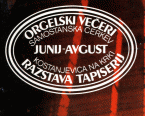
Tapestry exhibition
From the collection of Dekorativna factory, Ljubljana
Former Monastery Church, 28.06.1980
Tapestry exhibition. Accompanying organ evenings took place from June 26th, 1980 to August 1st, 1980.

